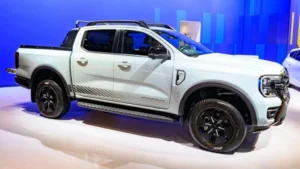American cars might be big, bold, and powerful, but when it comes to Europe, they just don’t sell as well as their European counterparts. With former U.S. President Donald Trump raising concerns over trade imbalances, the question arises: Why don’t Europeans buy more American cars? Let’s break it down! 👇

1️⃣ Size Matters: Narrow Streets vs. Big Vehicles
European cities, especially in places like Italy and France, have old, narrow streets. A massive Ford F-150 or Dodge Ram isn’t exactly easy to maneuver through cobbled roads! 🚧
2️⃣ Fuel Efficiency: The Price of Gas
In the U.S., gas prices are much cheaper compared to Europe. While Americans enjoy large, fuel-hungry SUVs and trucks, Europeans prefer smaller, fuel-efficient cars to save on costs. ⛽💰
3️⃣ High Tariffs & Trade Imbalances
Europe imposes a 10% tariff on U.S. car imports, while the U.S. charges just 2.5% on European cars. This imbalance makes European brands like BMW, Mercedes, and Volkswagen more competitive in the U.S. market, while American cars become pricier in Europe. 💸⚖️
4️⃣ Local Preferences: Brand Loyalty
European consumers are naturally inclined to buy homegrown brands. Germany loves its BMWs, Audis, and Volkswagens, while France sticks to Peugeot and Renault. American brands have to compete against established favorites. 🇩🇪🚘🇫🇷
5️⃣ Manufacturing Strategy: Build Where You Sell
Rather than shipping cars overseas, carmakers prefer to manufacture close to their customer base. BMW and Mercedes make some of their largest models in the U.S., and Tesla has a factory in Germany for its Model Y production. 🏭🔧
6️⃣ The Rise of Electric Cars & Chinese Competition
Tesla is one of the few U.S. brands successfully competing in Europe. However, it’s facing growing competition from affordable Chinese EVs, making the market even tougher. ⚡🇨🇳
7️⃣ Trade Wars & Innovation Challenges
Trump’s push for higher tariffs on European cars could trigger a trade war, but industry experts argue that protectionism stifles innovation. Instead of focusing on trade restrictions, the real key to success is investment, innovation, and global collaboration. 🌍🚀
🔥 Final Thoughts
While there’s no outright dislike for American cars in Europe, the combination of costs, fuel prices, regulations, and competition makes it difficult for them to dominate the market. Unless U.S. automakers adapt to European preferences—offering smaller, fuel-efficient, and affordable models—European consumers will likely continue to favor their homegrown brands. 🚗💨








